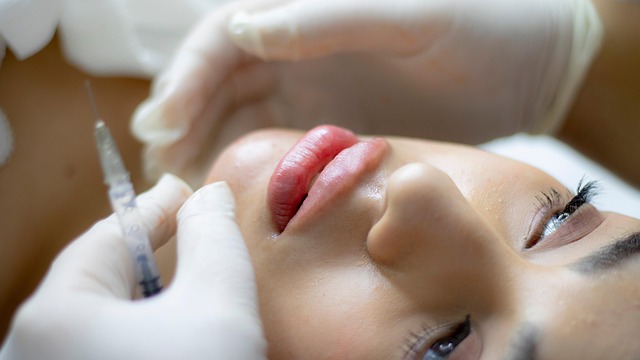Facial aging is influenced by muscle dynamics and expression lines. Both Botox and dermal fillers address these issues but differently: Botox relaxes muscles responsible for expressions, preventing dynamic wrinkles, while dermal fillers add volume to depressed areas. Botox is a popular anti-aging treatment due to its subtle yet effective results, retaining unique features. Dermal fillers instantly restore volume but carry slightly higher risks. The choice between them depends on individual needs—Botox for expression lines and dermal fillers for deeper static wrinkles or volume loss. Consulting a dermatologist ensures the best treatment based on skin type, age, lifestyle, and desired outcomes. Long-term Botox treatments offer gradual enhancements with regular top-ups every 3-6 months, providing a unique anti-aging approach when combined with dermal fillers.
“Facial aging is a natural process, but many seek ways to prevent or mitigate its visible signs. This article explores preventative measures for facial aging, focusing on two popular treatments: Botox and dermal fillers. We delve into the science behind facial dynamics, understanding how muscle movement contributes to wrinkles. By comparing Botox’s muscle-relaxing properties with dermal fillers’ volume restoration capabilities, we guide you through the decision-making process. Learn about safety considerations, potential side effects, and long-term results, helping you choose the best treatment for your anti-aging journey.”
Understanding Facial Aging: The Role of Muscle Dynamics

Facial aging is a complex process influenced by various factors, including muscle dynamics and expression lines. As we age, our skin loses elasticity, and underlying muscles can weaken or shift, leading to wrinkles and sagging. This is where preventative measures like Botox come into play. Unlike dermal fillers that add volume, Botox targets the root cause of dynamic wrinkles by relaxing specific facial muscles responsible for expressions.
Comparatively, while dermal fillers are effective in plumping up depressed areas, they don’t address the underlying muscle activity that contributes to aging. Botox offers a more holistic approach by non-surgically adjusting muscle dynamics, providing a younger appearance and preventing further wrinkle formation. Understanding these muscle dynamics is crucial when considering preventative Botox treatments for slowing down the natural process of facial aging.
Botox: A Natural Approach to Anti-Aging

Botox has emerged as a popular and effective natural approach to anti-aging for the face. Unlike dermal fillers, which add volume by injecting foreign substances into the skin, Botox works by relaxing specific muscles that contribute to the formation of wrinkles. This non-invasive procedure involves the injection of botulinum toxin into targeted areas, temporarily paralyzing the muscles responsible for frowning and squinting—the primary causes of dynamic lines and wrinkles.
The advantage of using Botox over dermal fillers lies in its ability to address specific concerns without altering the skin’s natural structure. It provides a subtle yet noticeable improvement by reducing the appearance of fine lines and crow’s feet, giving the face a more youthful and relaxed expression. This natural approach ensures that individuals maintain their unique facial features while achieving a smoother, rejuvenated look.
Dermal Fillers: An Alternative Solution for Volume Loss

While Botox is a popular choice for preventing facial aging, another effective alternative is dermal fillers. Unlike Botox, which works by relaxing muscles to prevent dynamic wrinkles from forming, dermal fillers enhance volume and shape by injecting a substance into the skin. This substance can be hyaluronic acid, collagen, or other materials approved by regulatory bodies, each offering natural-looking results that can last for several months.
Dermal fillers are particularly useful in addressing volume loss associated with aging, such as hollows under the eyes or thinning cheeks. They provide immediate results and offer a longer-lasting solution compared to Botox treatments. However, when considering Botox vs dermal fillers, it’s essential to discuss your specific concerns with a qualified professional who can advise on which treatment aligns best with your individual needs and goals.
Comparing Effectiveness: Botox vs Dermal Fillers

When considering preventative measures for facial aging, many individuals often weigh the options between Botox and dermal fillers. Both treatments have gained significant popularity in the cosmetic industry due to their ability to reduce signs of aging. However, they work differently and cater to specific concerns.
Botox is a neurotoxin that temporarily paralyses muscles, reducing dynamic wrinkles caused by facial expressions. It’s particularly effective for preventing crow’s feet, forehead lines, and frown lines. On the other hand, dermal fillers enhance volume loss associated with aging by injecting hyaluronic acid or collagen into the skin. They smooth out static wrinkles and add definition to the face, including cheekbones, jawline, and nose. The choice between Botox and dermal fillers depends on an individual’s specific needs and goals, as each offers unique benefits for preventing facial aging.
Safety and Side Effects: What You Need to Know

Botox and dermal fillers are both popular treatments for facial aging, but understanding their differences is crucial before choosing one. Safety is a top concern when considering any cosmetic procedure. Botox, made from a weakened form of botulinum toxin, has been extensively studied and is generally considered safe when administered by a qualified professional. Common side effects include temporary bruising, swelling, or discomfort at the injection site. In rare cases, it may cause more serious reactions, but these are typically manageable.
On the other hand, dermal fillers use substances like hyaluronic acid to add volume and smooth fine lines. While generally safe, they carry slightly different risks. Temporary redness, swelling, and pain are common, but more severe side effects such as infection or an adverse reaction to the filler are less frequent. Comparing Botox vs dermal fillers, Botox offers a more targeted approach, relaxing specific muscles responsible for dynamic wrinkles, while dermal fillers provide immediate volume restoration. Both have their merits, and discussing these options with a dermatologist can help determine the best choice based on individual needs and preferences.
Choosing the Right Treatment: Factors to Consider

When considering preventative measures for facial aging, understanding the difference between Botox and dermal fillers is key. Both are popular cosmetic treatments, but they serve distinct purposes. Botox, a neurotoxin, primarily targets dynamic wrinkles caused by muscle movement, providing a temporary yet effective smoothing effect. Dermal fillers, on the other hand, are hyaluronic acid-based substances injected to add volume and lift to the skin, reducing static signs of aging.
Choosing between them depends on individual needs. Botox is ideal for preventing expression lines from deepening, especially around the eyes and forehead. Dermal fillers, with their ability to plump and define, are more suitable for addressing deeper facial wrinkles, hollows, or lost volume in the cheeks and jawline. Consulting a dermatologist or a qualified aesthetic practitioner can help determine the most appropriate treatment based on skin type, age, lifestyle, and desired outcomes.
Long-Term Results and Maintenance Strategies

The long-term results of preventative Botox treatments can be truly transformative, offering a subtle yet significant lift and definition to the face. Unlike more invasive procedures, Botox’s effects are gradual, making it ideal for those seeking a natural-looking enhancement. Studies show that with regular top-ups every 3-6 months, the benefits can last for years, allowing individuals to age gracefully while minimizing visible signs of aging.
When considering maintenance strategies between treatments, it’s essential to understand the differences between Botox and dermal fillers. While both are popular anti-aging tools, their effects and approaches vary. Botox focuses on preventing muscle contraction, thereby reducing dynamic wrinkles, whereas dermal fillers add volume by plumping the skin with hyaluronic acid or collagen. By combining these techniques, a comprehensive anti-aging strategy can be tailored to individual needs, ensuring long-lasting results and maintaining a youthful complexion.
